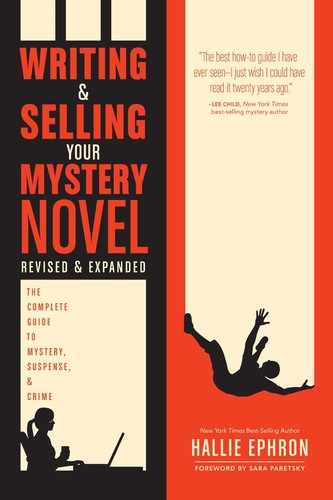Chapter 21
Puzzling It Out
Writing Reflection
“In mysteries, the penny-drop comes when the sleuth hears, sees, tastes, smells, touches or otherwise experiences something that, when combined (usually mentally) with a fact or facts gleaned earlier, tells the detective that ’til now, everyone has been following false leads.”
—Thomas B. Sawyer, head writer/producer of Murder, She Wrote
A mystery is about solving a puzzle. Puzzle solving requires thinking, so throughout your novel, and especially after suspense and action sequences, take time to pause, turn down the volume, and let your character (and the reader) think about what’s happened so far and put together the clues.
It’s all about getting to the aha moment when the sleuth realizes the significance of something which, up to that point, has seemed unimportant. For example, the aha moment might be the revelation of a secret that establishes a character’s motive for murder. It might be the discovery of evidence that explains how a crime was committed. When the metaphorical bulb lights up inside the sleuth’s head, facts and events snap into focus and the story is propelled forward.
You have two tools for dramatizing reflection:
- Dialogue: Characters discuss what happened and think aloud. Your sidekick and supporting cast become sounding boards for the sleuth.
- Internal dialogue: The reader is privy to a character’s thoughts.
REFLECTING IN DIALOGUE
One of the main reasons Sherlock Holmes needs Watson is so he can discuss the case and astound Watson and the reader with his mental acumen. Here’s an example of how it works.
This conversation between Holmes and Watson occurs near the end of “The Speckled Band”:
“Well, there is at least the curious coincidence of the dates. A ventilator is made, a cord is hung, and a lady who sleeps in the bed dies. Does that not strike you?”
“I cannot as yet see any connection.”
“Did you observe anything very peculiar about that bed?”
“No.”
“It was clamped to the floor. Did you ever see a bed fastened like that before?”
“I cannot say that I have.”
“The lady could not move her bed. It must always be in the same relative position to the ventilator and to the rope—for so we may call it since it was clearly never meant for a bell-pull.”
“Holmes,” I cried. “I seem to see dimly what you are hinting at. We are only just in time to prevent some subtle and horrible crime.”
Though this passage feels a bit wooden by today’s standards, every good mystery needs sequences of dialogue in which the characters puzzle things out and advance the story. Here’s what this bit of dialogue accomplishes:
- Reviews what happened: In case the reader missed anything in the preceding tumult, the characters highlight the clues (some may turn out to be red herrings): the coincidence of the dates, the nailed-down bed, and the rope that’s not a bell-pull.
- Presents the aha moment: The sleuth realizes the significance of a clue. Holmes concludes that the bedroom was arranged in that very peculiar way to facilitate a murder.
- Shows characters’ reactions: The characters sense the gravity of the implications. Even Watson gets it (“We are only just in time to prevent some subtle and horrible crime.”)
- Raises questions: Unanswered questions propel the story forward. In this example, the reader wonders about that sinister rope hanging from the ceiling—how was it used to commit a crime? And what crimes lie ahead?
Create opportunities like this for your sleuth to discuss the case and draw conclusions after turning points in the story.
Now You Try: Analyze Reflection in Dialogue
In this passage from Jonathan Kellerman’s Twisted, analyze how Detective Petra Connor and intern Isaac Gomez puzzle out the pattern behind a series of killings.
| Think about the following: | Excerpt from Twisted |
|---|---|
What clues are explained? What conclusions are drawn during the aha moment? How does Isaac show his reaction to this train of thought? What unanswered questions propel the story forward? | “There’s another discrepancy between Marta and the others. They were beaten to the ground and left there. She was killed on the street but placed in her car. You could look at that as her being treated with a bit more respect. Which would also fit with a killer who knew her well.” He grimaced. “I should have thought of that.” … “That’s why it’s good to brainstorm,” said Petra. They reached Santa Monica Boulevard. Traffic, noise, pedestrians, gay hustlers loitering on corners. Petra said, “Here’s another distinction for Doebbler: She was the first. When Detective Ballou told me he thought Kurt Doebbler’s reaction was off, and then after I met Kurt, it got me thinking: What if the bad guy never set out to commit a string of murders. What if he killed Marta for a personal reason and found out he liked it? Got himself a hobby. Which brings us back to Kurt.” “A once-a-year hobby,” said Isaac. “An anniversary,” she said. “What if June 28 is significant to Kurt because he happened to kill Marta on that day? So he relives it.” He stared at her. “That’s brilliant.” |
REFLECTING IN INTERNAL DIALOGUE
Reflection can also be expressed through internal dialogue. For example, in this passage from Laura Lippman’s Wilde Lake, state’s attorney Luisa Brant thinks about why she was attacked:
The EMT guys decide to let her go home, although with muttered imprecations about concussions, and while Lu scoffs at them, she finds herself unaccountably nervous as bedtime nears. She drinks cognac, knowing it’s a terrible idea—it will knock her out anyway. She simply cannot sleep. It’s not that she experiences the attack when she closes her eyes. Instead she has the strangest sense of déjà vu. That whooshing noise. A man running. Rudy at the door of the courtroom, so close to the outdoors for which he longed. Yes, the attack on her was a diversion, an attempt to throw the court into chaos. So why didn’t he then break for daylight, as the saying goes?
Because he’s crazy. But not crazy in the way that counts.
Reflection in internal dialogue achieves the same goals as spoken dialogue:
- Reviews what happened: Lu remembers the noise, the man running but not fleeing: … she has the strangest sense of déjà vu.
- Shows the character’s reaction: She drinks cognac… . She simply cannot sleep. Lu doesn’t have to say, “I was upset.” The reader can see from how she behaves that she is. As your character reflects, allow the memories to trigger an emotional response you can show the reader.
- Raises questions. … why didn’t he then break for daylight, as the saying goes? Lu moves point by point, frame by frame, raising questions that may send the story in a new direction.
- Presents the aha moment. Lu realizes how dangerous this man is (Because he’s crazy.). The character puts together the clues and makes sense of what happened, and in this case it raises the stakes to a higher level.
USING CONFLICT TO ADD SPICE TO REFLECTION
Conflict adds another dimension to reflection. It can be played out in dialogue (argument, debate) or internal dialogue (disbelief, self-doubt).
Here’s an example from Dennis Lehane’s Moonlight Mile. Patrick Kenzie argues with himself as he tries to sort out what he thinks:
There was zero connection between her whistle-blowing and her getting shot by some dumb, fucked-up kid in a parking lot at three in the morning. No connection whatsoever.
But it’s all connected.
This should not be about that, a voice said. You’re just pissed off. And when you’re pissed off, you lash out.
I leaned back in my seat, closed my eyes. I saw Beatrice McCready’s face—pained and prematurely aged and possibly crazed.
Another voice said, Don’t do this.
That voice sounds uncomfortably like my daughter’s.
Leave it be.
I opened my eyes. The voices were right.
I saw Amanda from my morning dream, the envelopes she’d tossed in the bushes.
It’s all connected.
No it’s not.
Here are some examples of the different kinds of conflict you can inject into reflection:
- The odd couple: Characters with opposite personalities have different takes on the same evidence. Think about how Mulder and Scully approach their investigations in the television series The X-Files. Or, for instance, how an older, jaded male homicide detective might pressure a less-experienced female medical examiner to highlight evidence that supports his theory about the murder, but she goes on to point out all the inconsistencies.
- Opposing desires or pressures: One character wants to move ahead with the investigation while another character wants to hold back. For instance, a reporter is eager to investigate a recent death that police have labeled a suicide; her editor wants her to stick to covering town politics.
- Credibility: Characters argue over the existence of evidence. For instance, an innkeeper hears a scream outside in the middle of the night and sees shadowy shapes moving about in the field. The police officer, who finds no evidence of a crime and no one else who heard those sounds, wonders if the innkeeper is dotty.
- Self-doubt: The character saw or felt something. He then questions his own senses and wonders if he’s overreacting, embellishing, or making it up.
- The war within: The character chokes on a decision he has to make to move forward. For example, a reporter has to decide whether revealing a source is ever justified, even to catch a killer.
- Withholding information: One character tells another a partial recap of events but lies about or withholds the complete picture. For example, a character might tell her father about what’s going on in a case but leave out the parts that would make her father worry about her safety; he’s no pushover, so he calls her on it.
Now You Try: Write Introspection (Worksheet 21.1)

Download a printable version of this worksheet at www.writersdigest.com/writing-and-selling-your-mystery-novel-revised.
Now You Try: Plan and Write Reflection
Pick a place in your outline where your characters need to stand back and reflect. Decide how you’re going to write that passage:
- Will you use dialogue, internal dialogue, or both?
- How can you include conflict?
- What’s the aha moment?
- What’s your point-of-view character’s emotion, and how are you going to show it to the reader?
- What unanswered question will propel the reader forward?
Now write that scene.
On Your Own: Writing Reflection
- Skim for action and suspense sequences in a few of your favorite mystery novels. After each sequence, does the author take time to let the characters think? Can you find an aha moment in each reflection sequence?
- Flag places in your outline where you think it would be appropriate to have your character sit back and reflect about what happened.
- Continue writing. Whenever you write a reflection sequence, use this checklist to guide your work:
___ Use sensory images to bring the thoughts alive.
___ Show your character’s emotional response.
___ Write the aha moment when your character realizes the significance of a clue or impending danger.
___ End with an open question that propels the reader forward.
___ Inject conflict (self-doubt, argument) wherever it makes sense.
